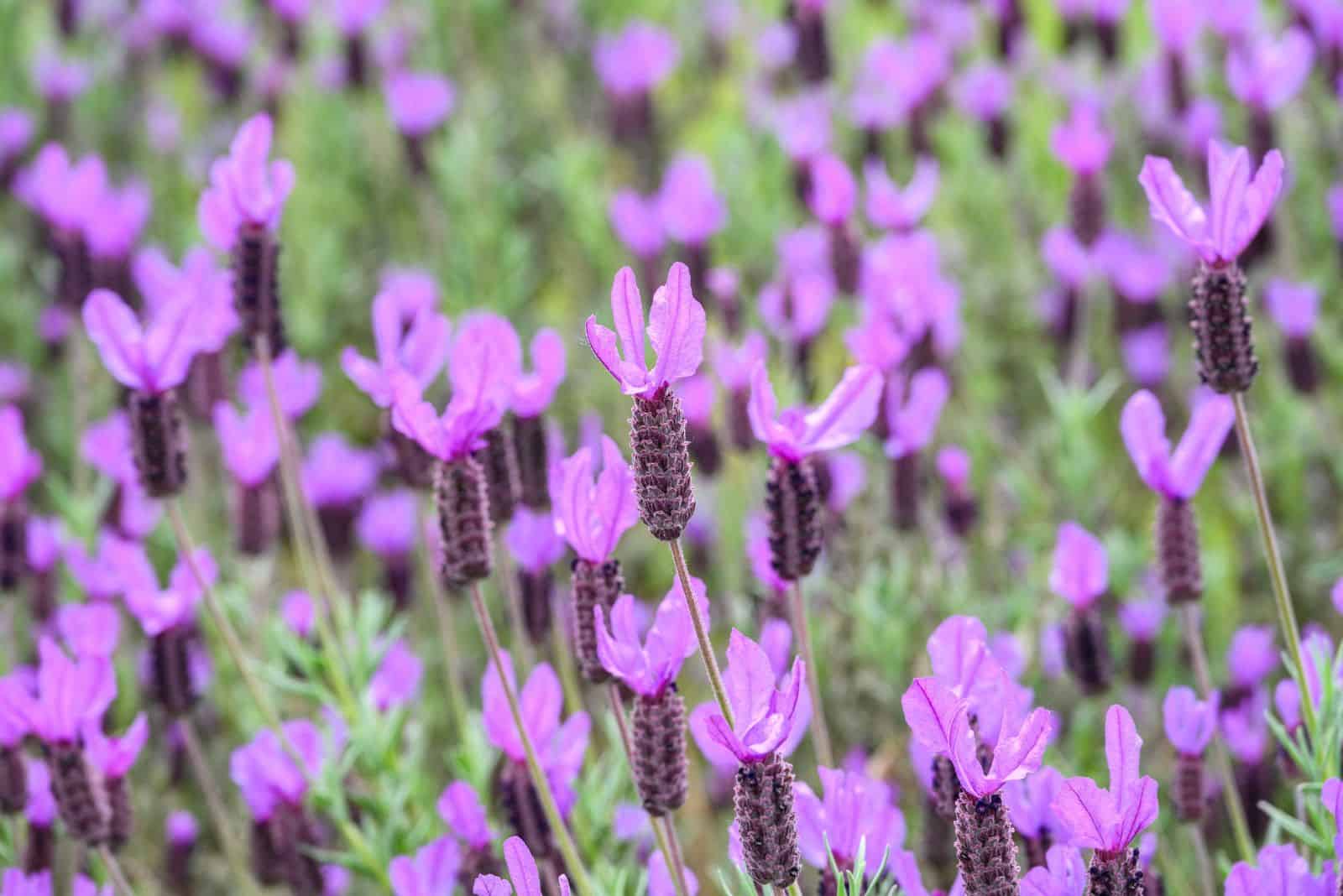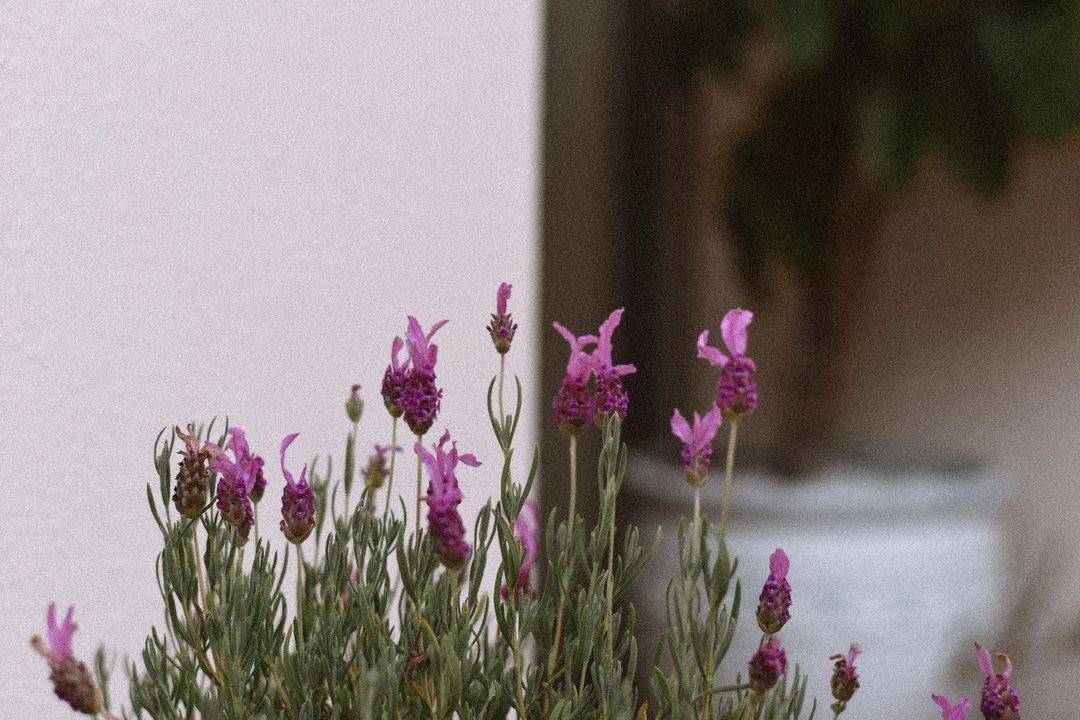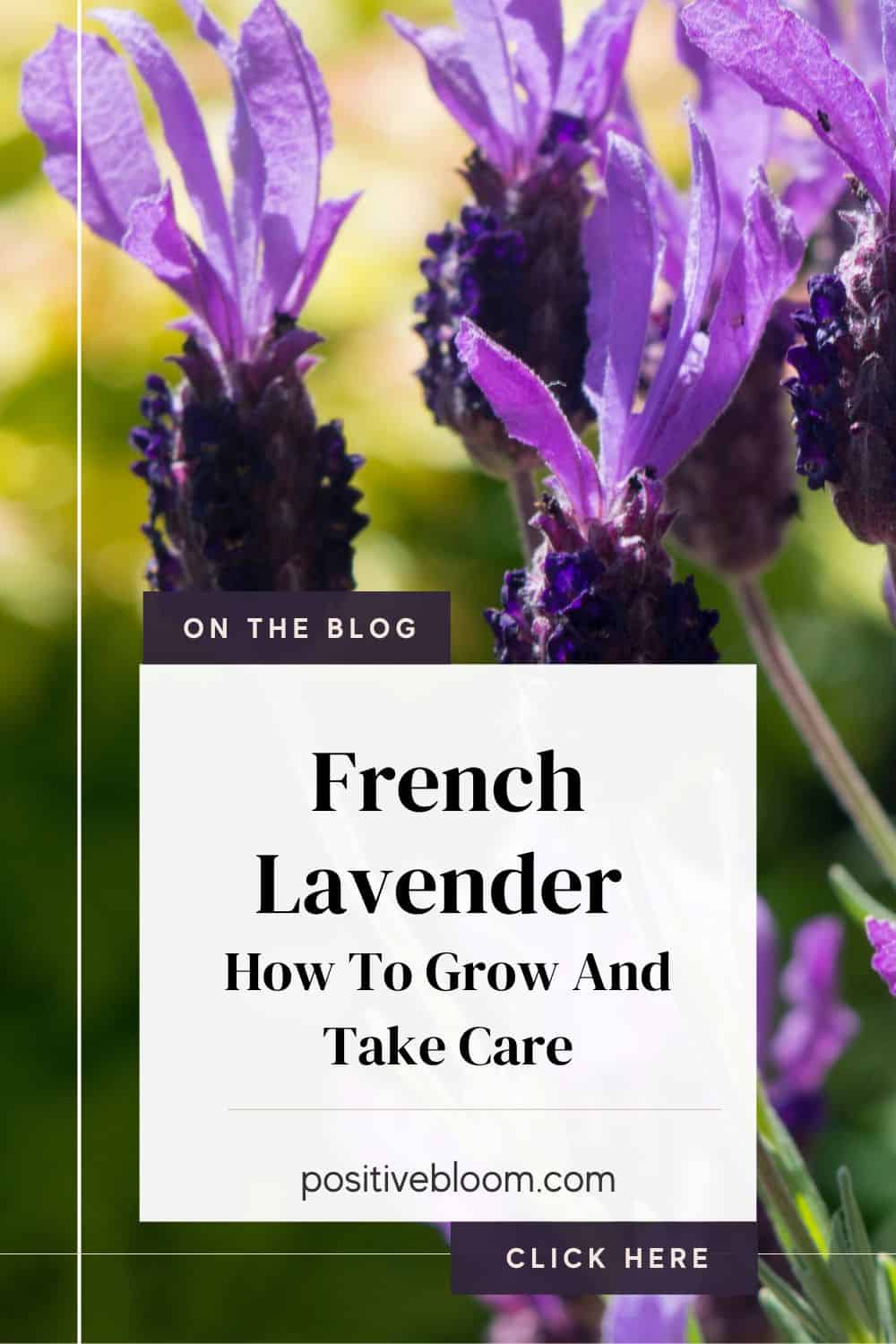Lavender is one of the most beautiful aromatic herbs you can plant in your garden, whether you want to attract more pollinators, repel pests, or simply add some color to your earthy pathways.
There are various types of this plant, and the most common are English, Spanish, and French lavender.
We’ll devote all our attention to the last one since it can grow in warmer and more humid climates, which makes it perfect for the South.
Before we get there, let’s learn some basics about this variety:
[table id=538 /]
How To Grow French Lavender
Before planting French lavender, choose a location with full sun conditions so you can enjoy an abundance of purple flowers.
After that, you can decide whether to grow the plant from seeds or transplant small plants you got from the nursery.
Growing French lavender plants from seed isn’t difficult, and all you need to do is fill a nursery tray with seed starting mix, place one seed in each cell, sprinkle it with a bit of soil, water it thoroughly, and move it to a warm and bright place.
Once the seeds germinate, you can wait until they grow a bit to move them to a larger pot or in the ground.
But, when is the best time to plant, transplant, or repot lavender? It’s in spring when the last frost date is long gone and your plant can bask in the warm sunlight before winter comes.
Planting French Lavender In The Ground
The good news is that all lavender varieties are planted in the same way, whether you wish to plant English lavender (Lavandula angustifolia), Spanish lavender (Lavandula stoechas), or French lavender (Lavandula dentata)
Just make sure to plant them about 2-3 feet apart, so there’s enough airflow between the plants to prevent the development of fungal diseases. And if you want to make a lavender hedge, you can bring them closer together and plant them about 1.5 feet apart.
Make sure the soil isn’t too fertile or heavy because it can lead to the development of root rot. You can add some kelp to give your plant an additional boost. Water in-ground lavender plants 1-2 times per week until they get established, then reduce it to 1-2 a month.
Mulch the plants with inorganic materials, such as gravel or anything which doesn’t retain moisture.
Planting Lavandula Dentata In Pots
When planting lavender in pots, whether it’s lavender from Spain or France, make sure to use a container with drainage holes and a well-draining growing medium to prevent overwatering.
You can also add a layer of small stones at the bottom of the planter to make it more draining.
Lavender in pots requires more moisture than those planted in-ground, so don’t refrain from watering too much. You can also mulch lavender in pots using mineral mulch.
And if you’ve just gotten your plant from the nursery, make sure to repot or transplant it right away!
French Lavender Care
Lavender plant care is really straightforward; keep the plant in a sunny location, water it only when the soil dries out, ensure higher temperatures, and plant it in slightly alkaline, low-to-moderately fertile, well-draining soil.
Of course, you’ll have to adjust the care for different climates because growing lavender in Florida is definitely not the same as growing it in Provence, for example.
But the care guide from below will help you with this and introduce a new companion to your sage and rosemary plants.
Light Requirements
All lavender varieties require full sun to thrive, and it’s the same with this one. Ensure it gets at least eight hours of light every day, whether you plant it in pots or the ground.
Potted lavender does best outside, but if the temperature is too cold, you can grow it indoors under some grow lights.
This plant can also benefit from light shade during the hottest part of the day, but anything longer than that will affect its growth. If lavender doesn’t get enough light, it can turn leggy and bear small blooms.
Water And Humidity
Lavender is a drought-tolerant plant that comes from the Mediterranean, so it doesn’t need too much moisture to thrive.
Generally speaking, you can water young lavender 1-2 times a week, but once it matures, you should reduce it to 1-2 times a month or stop irrigating it entirely if you live in a region with plenty of rain.
Potted lavender has slightly different needs; you should water it whenever the growing medium dries out.
Watch out for signs of overwatered lavender, such as droopiness and leaf discoloration, since they can help you notice the issue and save your plant from root rot before it’s too late.
Humidity
Lavender generally cannot handle high humidity, but this variety is slightly more tolerant of increased air moisture.
Therefore, you can grow it in Georgia, Florida, and all other states with similar USDA zones.
Temperature
Ideally, you should expose French lavender to temperatures between 70-75°F, although it can tolerate a broader range (from 65-85°F).
This variety isn’t tolerant of cold winters and won’t do well outside once the temperatures drop below 50°F.
Soil And Fertilizer
Lavender thrives in low-to-moderately fertile, well-draining, and slightly alkaline soils with a pH between 6.5-8.0.
It cannot grow well in fertile soils, which generally retain more moisture than this plant needs. Therefore, amend your garden growing medium with sand to make it less nutrient-rich and more draining.
And if you want to make your own potting mix, you can simply mix two parts compost or regular potting soil with one part horticultural sand. Add a dash of dolomite lime to increase the pH level of the growing medium and make it more alkaline.
Fertilizer
You can feed your lavender with a fertilizer that doesn’t have too much nitrogen (such as 7-9-5) or a highly-diluted well-balanced formula (such as triple 15).
Fertilize your plants only during the growing season and admire the abundant French lavender blooms.
Potted lavender would benefit from liquid fertilizer, but it would be best to feed in-ground lavender with a slow-release fertilizer or a layer of compost in spring.
Pruning French Lavender
Pruning is necessary if you want to admire bountiful lavender flowers. And the best time to do it is in late winter so it can rebloom and burst with color and blossoms.
Just take your pruners, cut the plant down to about six inches, shape it into a ball, and you’ll soon notice new growth.
Here are some more tips for trimming and cutting French lavender:
If you want more blossoms, you can snip the flowers in spring, so the plant forces out more blossoms.
And if you don’t know when different types of lavender bloom, you can always do some research and find out when specific varieties will adorn your herb garden with beautiful blossoms.
(We’ll let you in on a secret; in climates with mild winters, French lavender bloom time is all year round.)
Repotting And Transplanting
If your lavender has outgrown its pot or you have just gotten it from the nursery, you should repot it as soon as possible.
The best time for repotting and transplanting is in spring, but you can move it throughout the growing season.
Take it out of its current container and gently divide the roots if the plant is root bound. Plant it to the same depth as in its previous planter and backfill it with more substrate.
Water your repotted or transplanted lavender thoroughly, and you’re done!
Propagation
Multiplying French lavender isn’t a necessary step in its care, but it can save you a lot of money if you want to create a lavender hedge, decorate your patio, or frame a pathway.
You can propagate French lavender through root division or stem cuttings, and we’ll discuss both methods in the following sections.
You can also grow lavender from seeds; in that case, you might want to learn more about the lavender growth stages to provide your new plant with optimal care every step of the way.
Propagation Through Root Division
If your French lavender has more woody stems, you can divide it. Separate the roots carefully with as little tearing as possible.
Plant the divided plants into new pots or in the ground; just make sure the holes are deep enough to fit the entire root system.
Finally, the best time to propagate French lavender this way is on an overcast day when the sun won’t additionally stress it.
Propagation By Stem Cuttings
Take healthy cuttings in spring before the French lavender flowers. Remove the bottom leaves and plant them directly into the seed-starting mix.
You can also use rooting hormone, but that’s not necessary since the cuttings will develop a root system either way.
Move the cuttings to a sunny location, water them thoroughly, and let them develop.
You can also propagate lavender stem cuttings in water instead of a traditional substrate; just make sure that no leaves are underwater because they may rot and contaminate it.
Replenish the water every now and then, keep it in a bright spot, and once it develops a root system, you can transplant it into the soil.
Here are some more tips for multiplying lavender from cuttings:
French Lavender Plant Care In Winter
If you don’t live in USDA zones 8-11 but still want to grow French lavender as a perennial, you can simply overwinter it in your home.
Take your plant indoors before the first frost date and leave it in a cool location with plenty of light and airflow. Water it less frequently than during its growing season so it doesn’t catch root rot.
You can grow lavender in winter outside if you live in a warm region. In this case, you’ll want to cease watering altogether and remove plant debris and organic material that may retain too much moisture.
Common Problems With French Lavender
If you don’t know the differences and similarities between French and English lavenders, you won’t be in any trouble since they usually get attacked by the same pests and diseases.
The most common pests and diseases that attack lavender are whiteflies, spittlebugs, aphids, root rot, and leaf spot.
We’ll discuss why these issues appear on your French lavender and how to prevent and control them in the following sections.
Pests
Even though lavender is frequently used as a pest-repellent, it can still fall victim to aphids, whiteflies, and spittlebugs if it isn’t in the best shape.
Therefore, ensure you regularly prune your lavender, water it sparingly, and plant it at least 1.5 feet apart to increase air circulation.
If your plant still gets infested with aphids, whiteflies, or spittlebugs, you can introduce some ladybugs to eat their eggs and remove the infestation with neem oil or insecticidal soaps.
Diseases
Root rot and leaf spot appear because of inadequate moisture. Root rot occurs because of too much water in the soil, whereas high humidity and poor airflow result in leaf spot.
You can prevent these diseases by watering your plant only when the soil is dry, planting it in a pot with drainage holes, not wetting the leaves, and ensuring proper air circulation by planting the French lavenders at least 1.5 feet apart.
If this fragrant herb still gets infected with root rot, you should take it out of the soil, remove the diseased roots, spray the remaining parts with fungicide as a preventive measure, and plant it in fresh soil and a clean pot.
You can deal with leaf spot by removing the diseased foliage, spraying it with fungicide, and pruning the plant to increase airflow.
FAQ
We discussed the most important things regarding French lavender, such as how to grow it, care for it, and deal with its common issues, but there are some other things we need to mention before ending this article.
We found the questions you asked us most frequently and will answer them in the sections below.
How much does French lavender cost?
French lavender plants cost around $25-30 per plant. However, you can get seeds for about $3-5 and save money that way.
You only need to buy one plant, which you can divide immediately if it has two woody stems.
Where did the name French lavender originate?
French lavender comes from France, which is why it’s called that. However, its common name in this country is butterfly lavender.
There’s been some confusion concerning the botanical name of this plant. The Latin equivalent for this plant is Lavandula dentata and not Lavandula stoechas.
Both varieties are common in France, which is why they’re both referred to as French lavender, but the stoechas variety is actually Spanish lavender.
Finally, it’s not surprising that many beginner growers think that the famous Anouk is a French lavender cultivar when it actually belongs to the Spanish lavender species.
But there are cultivars such as Pure Harmony, Royal Harmony, and lavender allwood you can enjoy.
How long does French lavender last?
French lavender usually lasts for about five years, but its lifespan decreases drastically if you don’t prune it and don’t take good care of it.
Therefore, if you tend to this gentle perennial properly, it will last a long time.
What can you do with French lavender?
You can use French lavender to make potpourri, use dried flowers or sachets as a pest-repellent, make candles, soaps, mosquito sprays, or use it as a culinary herb to make lavender lemonade, cookies, etc.
Final Thoughts
This article brought everything you need to know about growing French lavender, from starting the seeds and planting them in the ground or in pots to caring for the plant properly.
Generally speaking, you should grow French lavender in full sun conditions and low-to-medium fertile, well-draining substrate, water it 1-2 times a month, and fertilize it once a year with a slow-release fertilizer.
But if you grow this variety in pots, you should feed it once a month with a liquid fertilizer diluted in water.
You also need to prune it regularly to prolong its lifespan, increase airflow, and prevent possible pest infestations and diseases.
Finally, if you live in regions with mild winters, you can keep your French lavender outdoors all year round. However, if your climate is cold, you should overwinter this variety indoors and take it outside once the weather warms up.
Until next time!
Like this post? Share or pin it for later!





